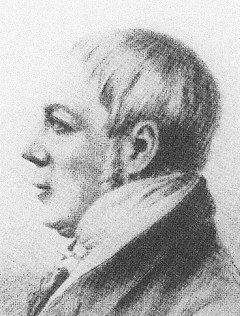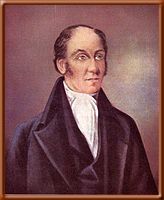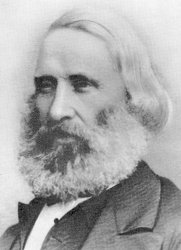
Northumberland is a county in Northern England, one of two counties in England which border with Scotland. Notable landmarks in the county include Alnwick Castle, Bamburgh Castle, Hadrian's Wall and Hexham Abbey.

John Blenkinsop was an English mining engineer and an inventor of steam locomotives, who designed the first practical railway locomotive.

William Hedley was born in Newburn, near Newcastle upon Tyne. He was one of the leading industrial engineers of the early 19th century, and was instrumental in several major innovations in early railway development. While working as a 'viewer' or manager at Wylam Colliery near Newcastle upon Tyne, he built the first practical steam locomotive which relied simply on the adhesion of iron wheels on iron rails.

Timothy Hackworth was an English steam locomotive engineer who lived in Shildon, County Durham, England and was the first locomotive superintendent of the Stockton and Darlington Railway.

Throckley is a village located in Newcastle upon Tyne, North East England, approximately 7 miles (11 km) west of Newcastle city centre. Hadrian's Wall passed through the village, its course traced by the village's main road, Hexham Road. Throckley lies within the historic county of Northumberland.

The Royal Grammar School (RGS), Newcastle upon Tyne is a selective British independent day school for pupils aged between 7 and 18 years. Founded in 1525 by Thomas Horsley, the Mayor of Newcastle upon Tyne, it received royal foundation by Queen Elizabeth I and is the city's oldest institution of learning. It is one of seven schools in the United Kingdom to bear the name "Royal Grammar School", of which two others are part of the independent sector.

Ruabon is a village and community in Wrexham County Borough, Wales. The name comes from Rhiw Fabon, rhiw being the Welsh word for "slope" or "hillside" and Fabon being a mutation from St Mabon, the original church name, of earlier, Celtic origin. An older English spelling, Rhuabon, can sometimes be seen.

Wylam is a village and civil parish in the county of Northumberland. It is located about 10 miles (16 km) west of Newcastle upon Tyne.
Richard Armstrong was an English writer who wrote for both adults and children. Most of his books were novels set at sea, or sea stories. For one of those, Sea Change, he won the 1948 Carnegie Medal from the Library Association, recognising the year's best children's book by a British subject. He is also known for a biography of Grace Darling in which he challenges the conventional story: Grace Darling: Maid and Myth (1965). He is often described on the cover of his books as "author and mariner".

Newburn is a semi rural parish, former electoral ward and former urban district in western Newcastle upon Tyne, North East England. Situated on the North bank of the River Tyne, it is built rising up the valley from the river. It is situated approximately 5 miles (8.0 km) from the city centre, 14 miles (23 km) east of Hexham and 13 miles (21 km) south south west of Morpeth. In the 2001 census, the population was given as 9,301, increasing to 9,536 at the 2011 Census. Newburn is in the Newcastle upon Tyne district of Tyne and Wear and is part of the parliamentary constituency of Newcastle upon Tyne North.
Benwell is an area in the West End of Newcastle upon Tyne, England.

Joseph Armstrong was an English locomotive engineer and the second locomotive superintendent of the Great Western Railway. His younger brother George and one of his sons also became outstanding engineers in the employment of the GWR.
George Armstrong was an English railway engineer. He was in charge of standard gauge steam locomotives for the Great Western Railway at Stafford Road Works, Wolverhampton, from 1864 to 1897. He was the younger brother of his colleague Joseph Armstrong, but thanks to the special requirements of the GWR at a time when it was split in two by the broad and standard gauges, the brothers were able to work largely independently of each other. George is best remembered for his 0-4-2 and 0-6-0 tank engines; these were long-lived, and even when life-expired they were replaced by Collett and Hawksworth with remarkably similar locomotives, the well-known 1400, 5700 and 1600 classes.
The first settlers of the South Shields area were the Brigantes, although there is no evidence they built a settlement at South Shields. The Romans built a fort there to help supply Hadrian's Wall. Many ruins still exist today. The fort was abandoned as the empire declined.

Blairhall is a village in West Fife, Scotland. It is situated 1.1 miles (1.77 km) west of Comrie, and 6.7 miles (10.783 km) west of Dunfermline. The village was originally a small hamlet but was expanded in 1911 to house the miners from a nearby colliery. Today Blairhall has a primary school and a community leisure centre. The village has a population of around 1000 people.

The Tyne Valley Line is a 58-mile (93 km) route, linking Newcastle upon Tyne with Hexham and Carlisle. The line follows the course of the River Tyne through Tyne and Wear and Northumberland. Five stations and two viaducts on the route are listed structures.

Henry Perlee Parker (1785–1873) was an artist who specialised in portrait and genre paintings. He made his mark in Newcastle upon Tyne in the 1820s through patronage by wealthy landowners and through paintings of large-scale events of civic pride. Over a period of forty years his work was exhibited at the Royal Academy and the British Institution in London. Coastal scenes of fisherfolk and smugglers were a popular specialism. Through the distribution and sale of mezzotint prints of subjects such as William and Grace Darling Going to the Rescue of the SS Forfarshire, Parker became one of the north-east's best-known nineteenth-century artists. In Newcastle upon Tyne he was central to the setting-up of a Northern Academy for the Arts. Later, in Sheffield, he taught drawing at the Wesleyan Proprietary Grammar School, and in his later years he lived in Hammersmith, London. He had a large family and was married three times.

Losh, Wilson and Bell, later Bells, Goodman, then Bells, Lightfoot and finally Bell Brothers, was a leading Northeast England manufacturing company, founded in 1809 by the partners William Losh, Thomas Wilson, and Thomas Bell.

Christopher Blackett owned the Northumberland colliery at Wylam that built Puffing Billy, the first commercial adhesion steam locomotive. He was also the founding owner of The Globe newspaper in 1803.
William Brown (1717-1782) - or William Brown of Throckley as he was sometimes known - was an English mining engineer, waggonway constructor and steam engine builder who played a major role in the development of the coal mining industry in the North East of England and also elsewhere in Britain and Ireland.
















